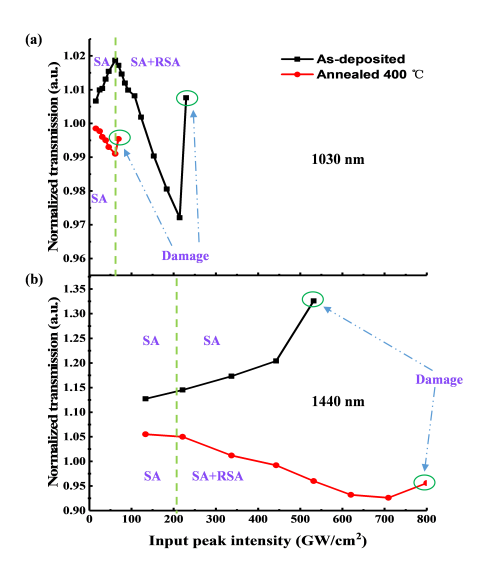Recently, researchers from the Shanghai Institute of Optics and Fine Mechanics (SIOM) of the Chinese Academy of Sciences (CAS) have revealed the competitive behavior of bound electrons and free electrons in Epsilon-Near-Zero (ENZ) materials irradiated by ultrafast laser pulses. They proposed the principle and method of synchronously tailoring the saturated absorption (SA) and reverse saturated absorption (RSA) of ENZ materials, which greatly broadened the ability to control the nonlinear optical response at the ENZ wavelength. The relevant study has been published in Photonics Research on April 15, 2021.
ENZ material means that in a specific wavelength range, the real part of the dielectric permittivity of the material approaches zero (ε~0). Theoretically, the limited dielectric permittivity change can obtain a great refractive index change. Therefore, compared with other nonlinear materials, ENZ materials have a larger nonlinear optical response, which is a research hotspot in the field of nonlinear optics.
The research group studied the nonlinear absorption response of a typical ENZ material (indium tin oxide) under the irradiation of a femtosecond laser. The results show that only SA behavior was observed at ENZ wavelength (1440 nm) whereas a conversion behavior from SA to RSA at the non-ENZ wavelength (1030 nm) with increasing incident laser intensity. The study analyzed the principle of the transition between SA and RSA in the non-ENZ wavelength. They believed that the SA effect originates from the bleaching process of free electrons in the conduction band, and the RSA effect originates from the multiphoton absorption of the bound electrons in the valence band.
In addition, researchers proposed thin film annealing technology to suppress free electron concentration, which achieves regulation of electron bleaching and multiphoton absorption competition. This method realizes the regulation from 120% saturated absorption to 95% reverse saturated absorption at ENZ wavelength.
Starting from the basic properties of ENZ material, the researchers analyze its nonlinear absorption mechanism and obtain a method for synchronously regulating ultrafast laser SA and RSA, which is expected to develop new applications in ultrafast optical field adaptive regulation, optical switching, and optical limiting.
The work was support by National Natural Science Foundation of China and Strategic Priority Research Program of the Chinese Academy of Sciences.

Figure1. Open aperture Z-scan results of as-deposited ITO films under excitation of 1030 nm at different input fluences. (a)、(b) 1030 nm, (c) 1440 nm. (Image by SIOM)

Figure 2. Dependence of normalized transmittance of ITO films (asdeposited and annealed) on optical intensity using different pump sources. (a) 1030 nm. (b) 1440 nm. (Image by SIOM)
Article website:
https://doi.org/10.1364/PRJ.417642
Contact:
WU Xiufeng
General Administrative Office
Shanghai Institute of Optics and Fine Mechanics, CAS
Email: xfwu@siom.ac.cn
Web: http://english.siom.cas.cn/